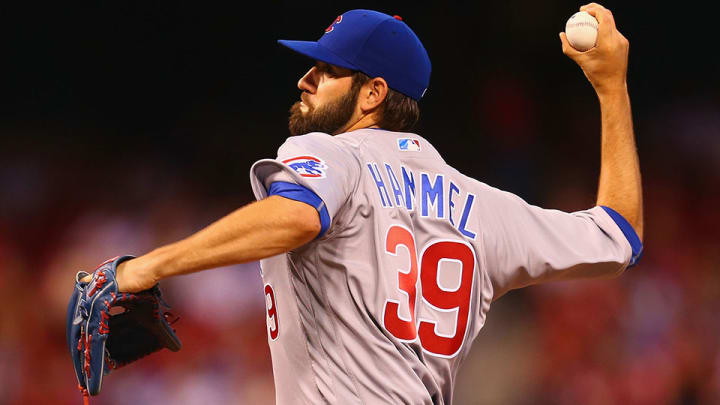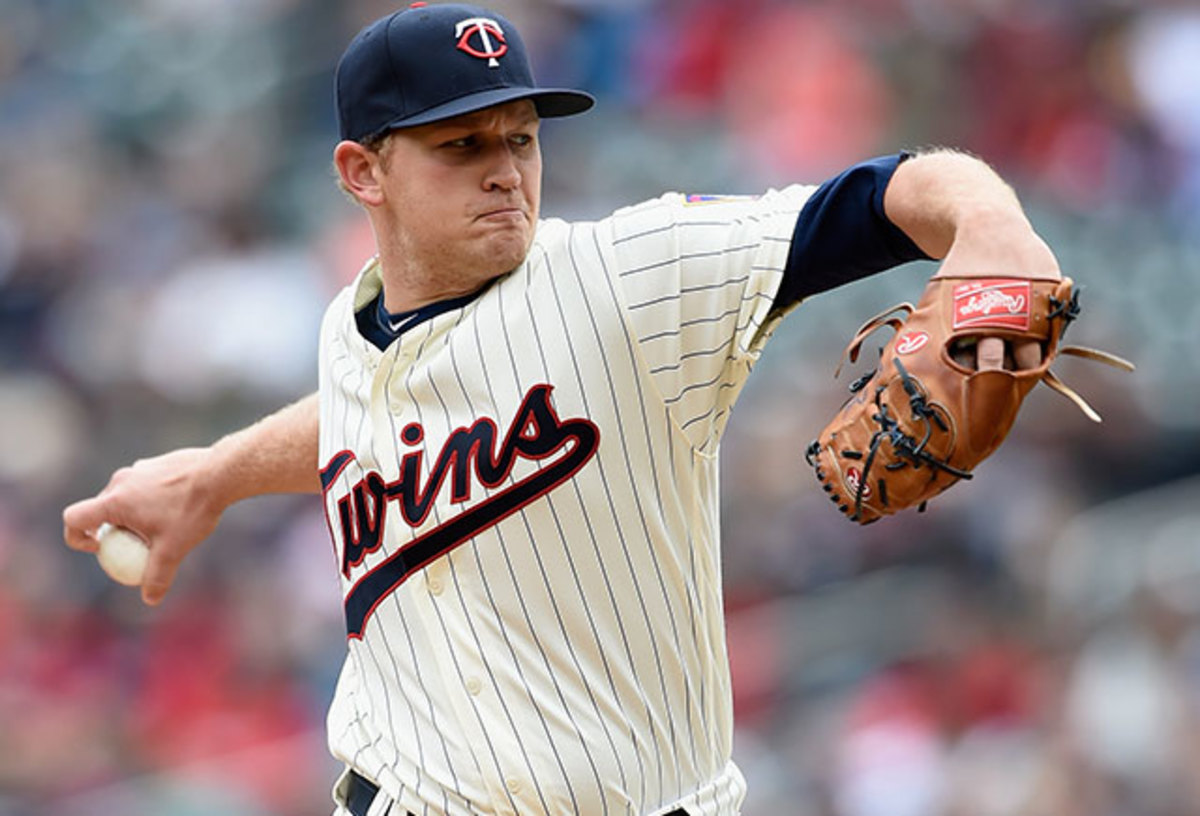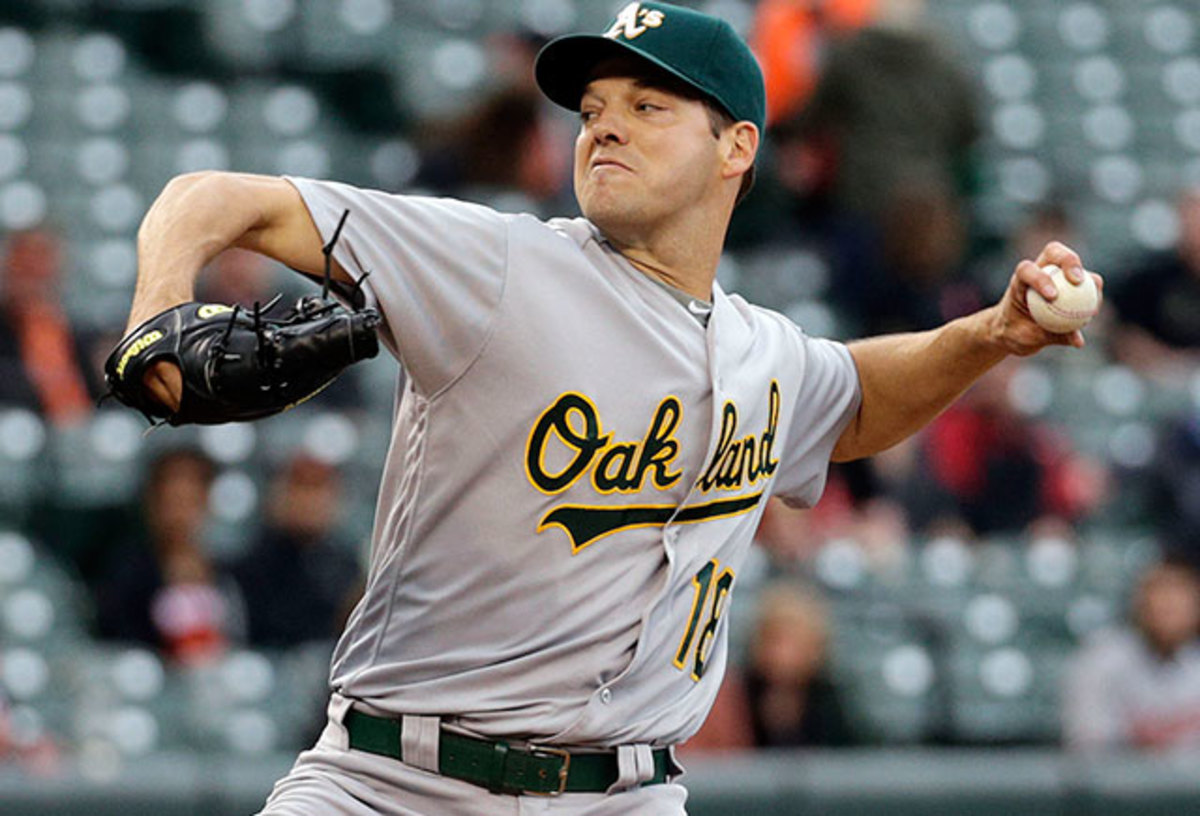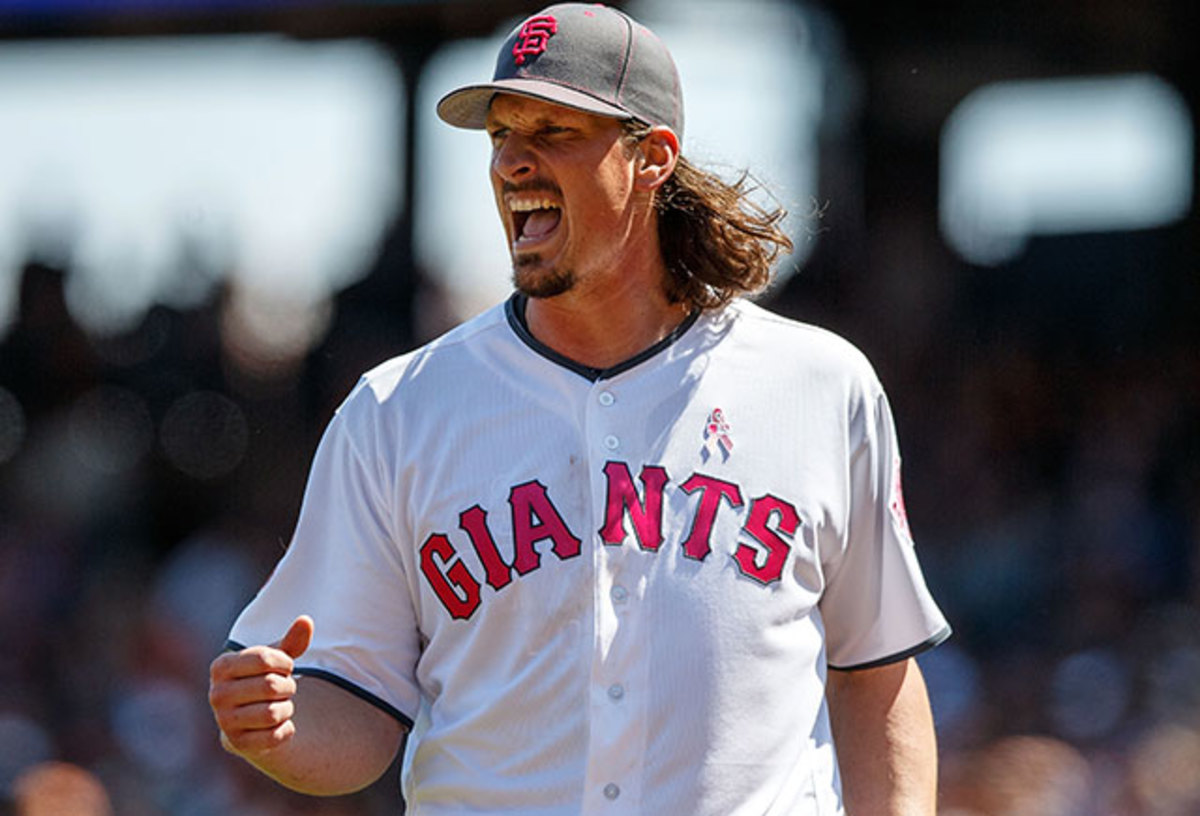The 30: Starting pitchers in focus for Week 5 MLB power rankings

The most unpredictable commodity in baseball, this season and every season, is pitching. Between the huge possibility of injuries and the year-to-year variance in results (which often have more to do with defense or luck than with the pitcher himself), the whole enterprise can feel like a crapshoot for almost anyone not named Jake Arrieta, Clayton Kershaw or Chris Sale.
Check in on any team in the majors and you’ll find at least one major pitching surprise. For the Giants, it’s been a former All-Star who has rediscovered his old stuff. For the Athletics and Cubs, it’s been two starters in their mid-30s, suddenly pitching better than they ever have before. For the sad-sack Twins, it’s been a subpar rotation now pitching like a terrible one.
Time to start pitching in. It’s Week 5 of The 30.
Best Cannon of the Week: Yasiel Puig
Yasiel Puig isn’t the hitter he used to be. A .319/.391/.534 force in his rookie season, he’s seen all his numbers plummet since then, and he now sits at a dreadful .243/.294/.396. But man, can he ever throw. First came the play Colorado's Trevor Story will see in his nightmares, when an attempt by the Rockies' shortstop to turn a double into a triple ended in tears.
On Friday, Puig was at it again. This time, the Blue Jays' Darwin Barney laced a line drive down the rightfield line. The ball took a fortuitous bounce off the side of the stands, allowing Puig to run toward it, and he came up firing on the run. For the Jays' second baseman, the play evolved into a disaster.
Best Moment in Baseball History of the Week: Bartolo Colon
As I was writing this week's edition of The 30, something miraculous happened: Bartolo Colon homered. HE HOMERED!!!!!!! Seriously!!!! That really happened!!!!
Here's SNY's Gary Cohen with the most joyous call in sports history:
En Español:
Bartolo Colon home run called by the Mets Spanish station WEPN: pic.twitter.com/eRdyvgI13U
— In Mets We Trust (@InMetsWeTrust) May 8, 2016
Here's Big Sexy forgetting he needs to drop the bat:
(Slow motion) Bartolo Colon carries his bat to first base following a home run pic.twitter.com/loHqyDR5qT
— Kenny Ducey (@KennyDucey) May 8, 2016
Here's Big Sexy rounding the bases at his own pace:
Nyquist ran the final 1/4 mile in 25.7 seconds
— ESPN Stats & Info (@ESPNStatsInfo) May 8, 2016
Bartolo Colon took nearly 31 seconds to round 4 bases
Here's Big Sexy back in the dugout:
when bae texts you back after not responding for an hour pic.twitter.com/mmPjbp1fEw
— Robby Kalland (@RKalland) May 8, 2016
And here's my totally rational reaction:
• MORE MLB: Why Bartolo Colon is the gift (and GIF) that keeps on giving

Lose, Twins
Minnesota’s dreadful rotation has overshadowed an encouraging start by an old friend.
30. Atlanta Braves (7–23 record, minus-63 run differential, last week: 30)
29. Minnesota Twins (8–23, minus-54, LW: 29)
28. Cincinnati Reds (13–19, minus-53, LW: 26)
27. San Diego Padres (13–19, minus-27, LW: 28)
26. Milwaukee Brewers (13–18, minus-40, LW: 27)
25. Los Angeles Angels (13–18, minus-17, LW: 18)
24. Houston Astros (12–20, minus-19, LW: 25)
23. New York Yankees (11–18, minus-25, LW: 24)
Few players in baseball get hammered more by local media than Joe Mauer. I won’t link to the many hit pieces written by Twin Cities scribes, featuring beefs ranging from Mauer not producing enough to earn his $184 million contract (somewhat fair, although he’s not the one who offered himself that contract) to arguing that sitting out games due to concussions makes him soft (the hottest of hot takes). So it’s extra gratifying to watch Mauer shove it in the faces of naysayers this year: He leads the American League with a .420 on-base percentage, and he reached base in his first 28 games this season before having that streak snapped last Friday.
Unfortunately for the Twins, Mauer’s terrific first five weeks (plus that of rookie slugger Byung-ho Park) have been thoroughly wasted by the rotation. Expected to be shaky, the starting five has instead been downright awful. Despite playing in one of the friendliest parks in the league for pitchers, Minnesota's starters rank dead last in the AL in ERA.
Explaining MLB's recent wave of PED bans, and what league can do
There’s plenty of blame to go around. Ricky Nolasco’s ERA sits at 4.70, Tommy Milone's is at 5.79, Phil Hughes's is at 5.85 and Kyle Gibson's is at 6.10 (and he's now on the DL). Those four ugly lines have played the biggest role in the rotation’s ERA climbing nearly a full run from last year’s semi-respectable 4.14 mark. But while those numbers are all worse than career norms (Hughes and Nolasco rank among the unluckiest pitchers in the league by strand rate), lousy results were to be expected: None of those four veterans rate as anything better than a No. 4 starter on a playoff team. Underwhelming starting pitching talent has been a common theme for the Twins for years. The team's current 10th-place AL rank in starting pitcher strikeout rate is actually its best result since 2010, when its starters finished a middle-of-the-pack eighth in AL strikeout percentage—before coming in dead last every year from '11 through '14.
The hope rests with the young guys, for both this season and beyond. Twenty-one-year-old rookie Jose Berrios is the big hope. The 32nd pick in the 2012 draft, Berrios was ranked as the 28th-best prospect in baseball headed into this season and was one of the most anticipated callups of the year when he got promoted on April 27. He’s lasted just 9 1/3 innings and shown iffy command over his first two starts, but he's also flashed the electric, swing-and-miss stuff that fueled his 484 strikeouts across 457 1/3 minor league innings.
But while Berrios might need some time to settle in at the big-league level, the favorite to be the Twins’ best starter this year might be the less heralded Tyler Duffey. An older prospect (he’s 25) with a lesser pedigree (he was a fifth-round pick in that same 2012 draft), Duffey has done nothing but produce since making his big league debut last summer. In 10 starts last year, Duffey fanned 53 batters and allowed just four homers over 58 innings, posting a 3.10 ERA in 10 starts. Sunday’s start against the White Sox reinforced his potential, as Duffey whiffed nine hitters over seven innings, taking the loss more because of lack of run support than through any fault of his own.
As a righthander with a 91-mph fastball, Duffey doesn’t possess the kind of wipeout stuff you’d expect from a staff savior. But with a tantalizing curve and a ground-ball-generating sinker, there’s enough here for Minnesota to dream on a consistent, effective mid-rotation starter, making no more than league minimum through the 2018 season. Given what the alternatives are for this perennially pitching-starved (and win-starved) club, that sounds like a wonderful dream.

Bending to his will
Rich Hill’s vexing curveball has been a rare bright spot for a slumping A’s team.
22. Arizona Diamondbacks (15–18, minus-20, LW: 23)
21. Oakland A’s (14–18, minus-24, LW: 19)
20. Detroit Tigers (14–16, minus-10, LW: 10)
19. Colorado Rockies (15–16, plus-1, LW: 20)
18. Tampa Bay Rays (15–14, minus-3, LW: 21)
17. Miami Marlins (16–14, minus-3, LW: 22)
16. Philadelphia Phillies (18–14, minus-27, LW: 16)
15. Kansas City Royals (15–15, minus-13, LW: 8)
On paper, hitting Rich Hill should be a snap. For one thing, there’s the track record: He hadn’t resembled anything close to a consistently good major league starting pitcher since 2007, before finally breaking a long run of injuries and ineffectiveness with four killer starts for the Red Sox to end last season.
Rich Hill's journey back to being a successful MLB starter full of curves
Those four starts were enough to convince the A’s to give Hill a one-year, $6 million contract. But the 36-year-old lefty lost all semblance of command in spring training, then pitched horribly in his first regular-season start, surrendering four runs in 2 2/3 innings against the White Sox before getting the early hook. Sure, Hill had talent, even at an advanced age: His curveball could be an absolute heartbreaker, not only tough to pick up and tough to hit but also a pitch that he could fire all over the strike zone. The secret for opponents, then, was to wait on his fastball. Odd as it might sound, the pitch that most pitchers tend to throw the straightest was the one that would often desert Hill, resulting in lots of walks and sometimes a bunch of crushed hits when the fastball floated into the middle of the plate.
Yet in the six starts since that first calamity (which was a fill-in assignment on short notice), Hill has allowed just seven earned runs in six starts. In 38 innings, he’s punched out an eye-popping 43 batters. Essentially a two-pitch pitcher, Hill has neutralized opponents with both his hook and his heater: Opponents are batting .167 against the curve and just .212 against his fastball, and when they don’t swing through those pitches, they’re often pounding balls into the turf: Hill has hiked his ground-ball rate to just shy of 48% over his past 11 starts, including that four-start flourish last year.
The question now becomes if this will hold. Though Hill has ceded just four hits in his past two starts, he’s also walked seven batters over that stretch. Even when the walks don’t pile up, Hill’s erratic command leads to high pitch counts, which is how a pitcher this dominant has tossed more than six innings just once this season. He’s caught some breaks too. Against Baltimore on Saturday, he needed 103 pitches to get through 5 2/3 innings, then left the game with two men on after allowing a run on a single, a hit-by-pitch and a fielder’s choice, also walking a batter. But reliever Ryan Dull struck out Jonathan Schoop to end the inning, preventing further damage. Hill’s 78.4% strand rate ranks 16th among AL starters and has helped him tiptoe around those lapses in control.
The bigger issue could be health. That Hill is pitching at all in the majors in 2016 is a minor miracle. He’s fought through Tommy John surgery and multiple other maladies over the past few years, and stamina could become a major issue given how long it’s been since he’s made it through a full season intact. Still, if the A’s—or Hill’s own strike zone adventures—can limit his workload, this could turn into one of the best stories of the season, no matter how the rest of the team fares.

Shark Attack
Jeff Samardzija’s brutal 2015 campaign looks like a distant memory.
14. Toronto Blue Jays (16–17, plus-11, LW: 15)
13. San Francisco Giants (17–16, plus-1, LW: 13)
12. Los Angeles Dodgers (16–15, plus-14, LW: 14)
11. Cleveland Indians (15–13, plus-18, LW: 17)
10. St. Louis Cardinals (16–16, plus-40, LW: 9)
9. Texas Rangers (18–14, plus-15, LW: 11)
8. Pittsburgh Pirates (17–14, plus-8, LW: 5)
7. Baltimore Orioles (18–12, plus-20, LW: 7)
6. Boston Red Sox (18–13, plus-23, LW: 6)
5. Seattle Mariners (18–13, plus-26, LW: 12)
White Sox general manager Rick Hahn’s furious shopping spree after the 2014 season seemed like it could fuel a big turnaround for a flagging Chicago team. The pitching moves that he made figured to be particularly useful: Two very good relievers and one front-line starter could give any team a boost, especially for a team coming off a 73–89 season. When that front-line starter turns into an arsonist, though, that will quickly scuttle any hopes of a victory parade. Jeff Samardzija’s ERA swelled up by more than two runs in 2015, ending at 4.96—by far the worst mark of his career for any full season.
So when the Giants signed Samardzija to a five-year, $90 million contract last winter, plenty of skeptics shook their heads in confusion. Even if the friendlier confines of AT&T Park figured to help keep a handful of fly balls from flying over the fence, the declines in his strikeout and ground-ball rates to multi-year lows combined with his velocity ticking lower made that kind of long-term investment look like folly.
Loss of Richards to Tommy John surgery is crippling blow to Angels
Seven starts into the 2016 season, the Shark looks like he’s almost all the way back to his old form. His strikeout rate is back to 2013 and '14 levels, near 23%. His ground-ball rate has soared to a career-best 51.1%. Hitters are making less contact on all his pitches, be they in the zone or otherwise. He has slashed his home-run rate to its lowest level in five years, thanks both to better pitches and the move from U.S. Cellular to his new home park/wireless provider. And his 3.19 ERA is backed by the best fielding-independent results of his career.
If there’s one small morsel of concern (other than trusting this performance to keep going for another 150 starts through 2020), it’s Samardzija’s fastball velocity, which is still sitting around 94 mph after hovering at 95.5 in 2013 and '14 and briefly above 96 in '12. The good news is that his repertoire is evolving, even as his heater devolves slightly. Once his go-to pitch, Samardzija now throws a four-seam fastball just one-sixth of the time. He’s become primarily a sinker-cutter pitcher, hurling his cutter on about three out of every 10 pitches and seeing career-best results with that pitch.
While other teams have tried to emulate the Royals and win with deep bullpens, the Giants have taken the opposite approach, spending big on starting pitching and hoping the old way is the best way. With Samardzija and fellow big-ticket free agent Johnny Cueto excelling alongside Madison Bumgarner, San Francisco could pose a formidable threat to October rivals ... if it gets that far. Given how games started by Matt Cain and Jake Peavy have more or less become automatic losses, the only regret the Giants might have about Samardzija is that they didn’t sign a couple more pitchers just like him.
Dropping the Hammel
The Cubs’ fourth starter is pitching like most other teams’ aces ... for now.
4. Washington Nationals (19–12, plus-41, LW: 3)
3. New York Mets (19–11, plus-44, LW: 4)
2. Chicago White Sox (22–10, plus-34, LW: 2)
1. Chicago Cubs (24–6, plus-102, LW: 1)
The Cubs have won seven games in a row. Their run differential is more than twice as big as the next best team’s (the Mets' +44). Three of their pitchers rank among the National League's top four in ERA. Oh, and they’re on pace to win 130 games; according to advanced analytical research, that would be pretty good.
Jake Arrieta leading the league in ERA should surprise no one. Last year’s Cy Young winner finally had a shaky start at Wrigley Field after seemingly dominating there since the Herbert Hoover administration. But even after allowing 10 base runners and three runs over five innings on Sunday against the Nats, Arrieta still leads the NL with a 1.13 mark (and the Cubs still found a way to win the game). Jon Lester’s 1.58 ERA counts as a bit more of a surprise, though when you sign a pitcher to a $155 million contract, it’s reasonable to hope for more than a solid No. 2 with an occasional case of the yips. But the biggest eye-opener has been the early-season dominance of Jason Hammel. When a 33-year-old righthander with a career 4.43 ERA is suddenly besting the likes of Clayton Kershaw, that’s a hell of a story.
The Chronicles of Reddick: How Josh Reddick reinvented himself with A's
If you had to pick the pitcher among Duffey, Hill, Samardzija and Hammel who’s most likely to get visited by the regression fairy, however, Hammel would be the best call. First, Hammel is sporting the lowest strikeout rate of the four, a 20.3% mark that’s around league average. Second, Hammel has walked 10.1% of the batters he's faced this season, and pitchers who walk more than 10% of the batters they face rarely stay out of trouble for long. Hammel has dodged the raindrops thanks partly to a microscopic home-run rate (0.26 homers per nine innings, with a 3% home-run-to-fly-ball rate) that’s far below his career norms and unlikely to last. His performance in tough spots has been an even bigger factor: Opponents are batting .257/.333/.371 against him with nobody on base and an impossibly low .121/.118/.121 with runners in scoring position. His last two starts, with just five innings pitched each time and 14 base runners allowed over those 10 innings, point to an imminent end to his Cy Young-level run prevention.
The good news is that this probably won’t matter all that much. The Cubs have spent the past few years accumulating as much talent as possible, then building contingency plans on top of contingency plans. Kyle Schwarber goes down for the season? Good thing they’d already re-signed Dexter Fowler when the market bottomed out for his services, thus providing ample on-base skills to cover for Schwarber’s absence with much better speed and defense thrown in. Jason Heyward off to a terrible start in the first year of his $184 million contract? Fortunately, Chicago spent less than one-third that amount on Ben Zobrist, adding yet another premium OBP threat to the lineup. If a starting pitcher falters or gets hurt, the Cubs have not one, not two, not three, but four converted starters toiling in the bullpen to pick up the slack.
Things won’t look this rosy forever, of course. The all-time record for wins in a season is 116, and while Chicago has built an impressive stable of talent and depth, an injury to, say, Anthony Rizzo (or even worse, Arrieta) could be much tougher to overcome. Of course, pull the best one or two players off any team, and it starts to look vulnerable. As we start to leave the point where we can still say “it’s early,” one thing looks crystal clear: The Cubs are the best team in baseball.
